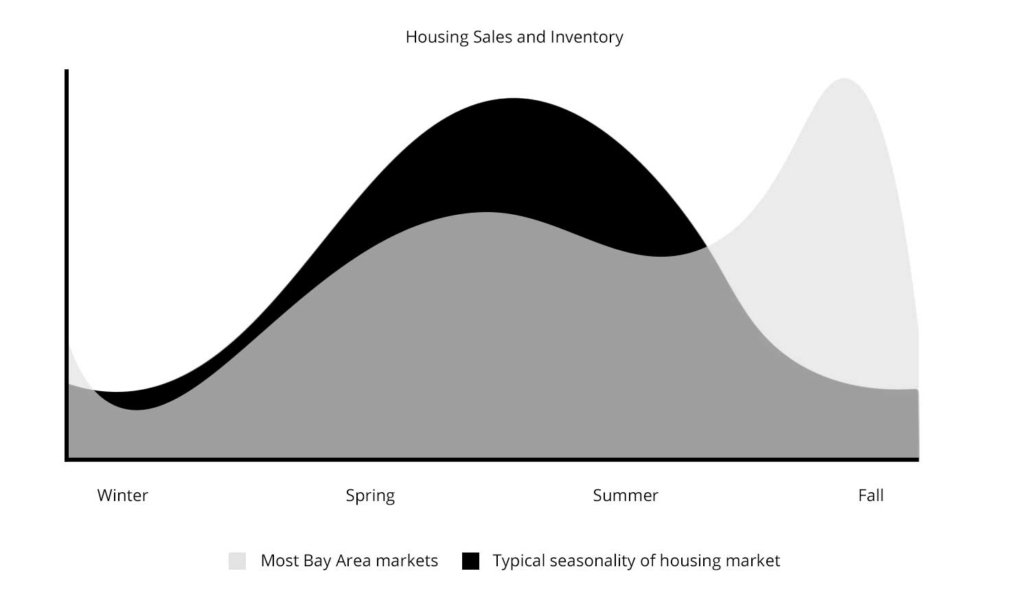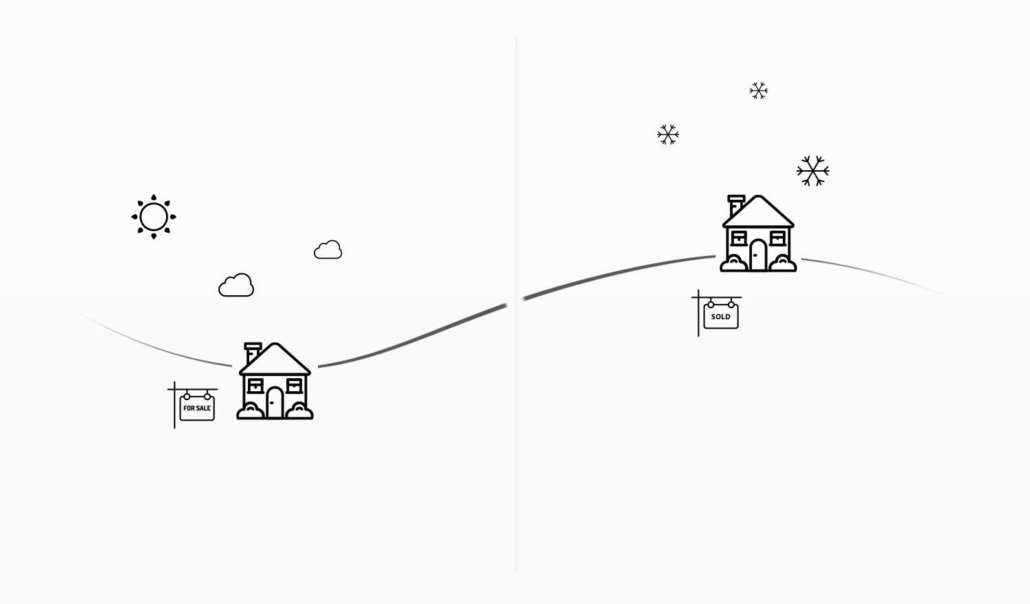How Seasons Impact Home Buying and Selling in Northern California
June 14, 2020
The housing market in Northern California fluctuates throughout the year, with an increase in home sales in the spring and a decrease in the winter.
These fluctuations are influenced by the inventory of available homes, home prices, buyer motivation and sincerity, and the beginning and end of the school year.
If you are planning to buy or sell a home, you should be aware of how these seasonal changes may affect your experience.
Having a solid understanding of these seasonal changes may help you sell your home quickly and for the best price or buy a home that is affordable and meets the needs of your family.
Below are some ways the seasons impact the housing market.
The housing market fluctuates according to the seasons.
In Northern California, as well as in the rest of the country, the housing market fluctuates greatly with the seasons. This includes home prices and the inventory of available homes for sale.
Seasonal Changes in Inventory
In Northern California, the housing market is fairly slow during the holidays – the period from mid-November to mid-January, when most people are too busy with holiday activities and family celebrations to take on the hassle of moving during this time.
Winter home buyers may face fewer options since inventory tends to be lower in the winter months, and they may begin to feel desperate to find a home quickly. With fewer homes on the market, buyers may take longer to find the right home during the winter.
Sellers whose listings haven’t sold before the holidays sometimes withdraw their listings in December when getting a good price and selling quickly are less likely. They then relist their homes at the beginning of the spring season when homes are more likely to sell quickly.
In the spring, the number of new listings picks up before slowing down by the end of the summer.
And from Labor Day through early autumn, the number of listings picks up again before dropping off in November. This results in a large increase in home sales activity in the spring and another smaller increase again in the early fall.
The luxury homes market tends to see an increase in listings in September, as the autumn sales season begins.
Seasonal Changes in Home Sales
The number of homes sold increases by 34 percent in the early spring season between February and March.
This increase continues during the months of May, June, July, and August, which are the busiest months for home sales.
Typically, home sales activity peaks in June. Home sales during this period of time make up 40 percent of the total annual sales volume.
Home sales activity decreases during the winter months, and the months with the lowest sales activity are November, December, January, and February. January tends to be the month with the slowest home sales activity.
In the Bay area, the seasons may have a slightly different effect. In Napa and Sonoma Counties, there is a large market for second homes. Home sales in these areas tend to peak in mid to late-summer, with an increase of listings in September and sales in October. Since it takes a few weeks for a sale to close, we see these sales figures reflected in the month of October before dropping off toward the end of the year.
If you live in San Francisco, the best month for you to sell your home is May, which means you should list your home in March. This may bring you 4.52 percent more profit than the annual average, according to transaction data provided by HomeLight.
According to this data, if you live in Sacramento, November may be the best month to sell your home, which means you should list your home in September. This may bring you 3.11 percent more profit than the yearly average.
While winter may typically be a slower season for home sales, buyers who are looking for homes in the winter may be more sincere and more motivated than those who are home shopping in the spring.
A home in Sacramento would typically have 50 to 100 potential buyers come through during open houses in the summer and may have around 10 offers. In the winter, there may only be a dozen potential buyers at open houses and between one and three offers.
Many of those moving during the winter may be relocating because of a job change, experiencing financial difficulties that require a quick move, or going through changes in the family, such as separation or divorce.
Buyers in these situations may not be able to wait until the peak season to move since time and money are factors that require them to move quickly.
At the opposite end of the spectrum are buyers who aren’t in a hurry to move. They start looking in the early spring when more homes are beginning to come on the market.
Because these buyers have more options from which to choose, they tend to feel that they can take their time finding the right home.
Buyers with young children can be extremely motivated during the later months of the summer, as they are trying to get into a new home before school starts if their children will be attending a new school.
Many families prefer to relocate in the summertime.
According to data from the National Association of Realtors (NAR), homebuyers tend to prefer the summer months for moving, especially families with school-aged children living at home. A summer move makes it easier for children to get acclimated to their new communities and start attending new schools at the beginning of the school year, rather than moving during the middle of the school year.
As the school year ends, many families have more free time to prepare their homes for sale and look for new homes since they no longer have the responsibility of afterschool activities or helping their children with schoolwork.
You may be able to get your price in any season.
While there are seasonal fluctuations in the housing market, and more homes sell in the spring than in the winter, it may still be possible for you to get a good price for your home regardless of the season.
With the early spring buying season, there are a higher number of homes on the market, which is great for buyers since they have more choices. Sellers will also have more competition with so many other homes available.
And the lower number of buyers and available inventory may result in fewer homes being sold during the winter, but it also means there are fewer available listings for buyers to consider, leaving your home with less competition.
Either of these situations could work to your advantage if you price your home correctly and find the right buyer since homebuyers generally don’t mind paying a fair price for the right home.
It may be difficult to decide when the best time is to buy or sell a home, and there are seasonal factors to consider in deciding this. Whether you are planning to sell your home or buy a new one, keep these seasonal changes in mind to help you get the results you want as you go through the process.
Sources:
https://www.bayareamarketreports.com/trend/seasonality-and-the-real-estate-market
https://www.nar.realtor/blogs/economists-outlook/seasonality-in-the-housing-market
https://www.sfgate.com/realestate/article/best-time-to-sell-your-home-San-Francisco-14054304.php
https://www.investopedia.com/articles/investing/010717/seasons-impact-real-estate-more-you-think.asp
https://www.upnest.com/1/post/when-is-the-best-time-to-sell-a-home/
https://goldenstatemortgage.com/best-time-buy-house-california/
https://goldenstatemortgage.com/best-time-buy-house-california/
https://www.trulia.com/blog/what-you-need-to-know-about-buying-a-home-this-winter/
https://www.bayareamarketreports.com/trend/seasonality-and-the-real-estate-market
https://www.homelight.com/best-time-to-sell-house/san-francisco-ca
https://www.homelight.com/best-time-to-sell-house/sacramento-ca

As a homeowner, at some point, you may want to make changes to your home. This may range from minor updates to more major renovation projects, but some of these projects are costly and may not bring you a good return on investment (ROI). According to the Remodeling 2019 Cost vs. Value Report , some remodeling projects have a greater ROI than others. The information in this report covers a wide variety of both interior and exterior projects and is specific to the San Francisco area. While this report contains useful information, it does not include the cost of sweat equity. These cost estimates are based on using paid outside labor. It also does not include information on smaller projects that homeowners commonly do to upgrade their homes, such as cabinet refacing, laminate and vinyl floor installation, bathtub refinishing, and painting. If you are preparing your home for sale, you can use the information in this report, along with current trends in renovation projects, to help you make the best decisions to make your home more appealing to potential buyers.

Remodeling your home can be a huge undertaking and a large investment of time and money. You may not be concerned about this if you don’t plan to move for a while, but if you are planning to sell your home anytime soon, there are several things you should take into consideration. If you know who your potential buyers might be, what types of homes they are interested in purchasing, and which remodeling projects are the best and worst investments, you can be confident in your decisions about how you prepare your home for sale in Sacramento. So, how do you determine how much you should spend and which projects you should do versus which ones are less important? According to the Remodeling 2019 Cost vs. Value Report , there are certain projects that may have a higher return on investment (ROI) than others. This data is specific to remodeling projects in the Sacramento area, and we will discuss some of these projects below.

The recent onslaught of wildfires has left many communities in Northern California devastated. The effects have been immense as fires have destroyed hundreds of thousands of acres of land, wiped out countless neighborhoods, and even leveled the entire town of Paradise. This destruction has left thousands of people without homes and faced with the burden of trying to rebuild their lives. For many residents, recovering from this disaster has meant finding temporary housing, rebuilding their homes, or relocating to different communities. While Northern Californians take on the arduous process of recovering, they face the challenges of the aftermath in the form of mental, emotional, and economic struggles. Below are some of the ways in which the wildfires have affected the housing market.

When you purchase a home with land, there are red flags that may alert you to potential problems. These issues don’t necessarily mean you shouldn’t purchase the property, and most of them may be easily resolved, but it is important to be informed about any issues that may affect your ability to enjoy your new property and use it as intended. Below are 10 potential red flags to watch out for before purchasing your new property. Easements Issues Water Rights Faulty or Inadequate Septic Systems Contaminated Well Water Boundary Disputes and Surveys Usability of the Land Restrictions on Building Additional Structures Ingress or Egress Issues Electrical Power Source on Raw Land Nonexistent or Inadequate Internet Access

If you’re thinking of selling your home, you have probably wondered about its marketability. Will potential buyers be impressed with your corner lot, stainless steel appliances, or three-car garage? Will they be deterred by an outdated bathroom, a 20-year-old HVAC system, or leased solar electricity equipment? As you prepare your home for sale, there are some foundational things you can do to make your home more appealing to a large percentage of potential buyers. Below are some of the most common and important factors that affect how attractive your home is to potential buyers.






